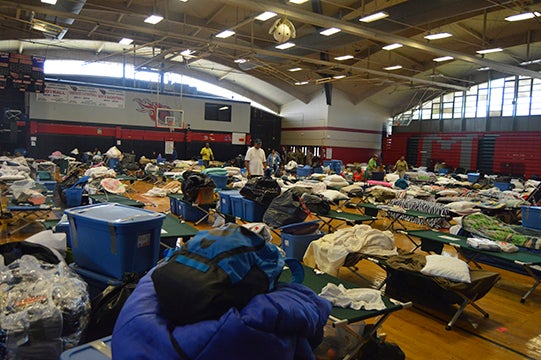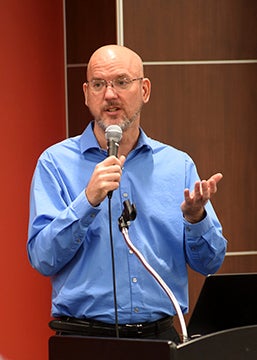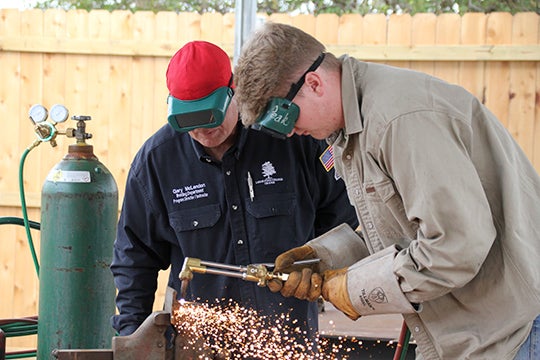BEYOND THE STORM — Tenacity and Grit: Lessons learned for Port Arthur Independent School District
Published 5:23 pm Tuesday, May 1, 2018

- The Thomas Jefferson Middle School gym serves as an evacuee shelter in this photo taken Sept. 15, 2017. (Lorenzo Salinas/The News)
The Port Arthur Independent School District learned much from the devastation Tropical Storm Harvey brought to Southeast Texas.
At a time when residents, officials and first-responders struggled to cope with the day-to-day hardships of a historical flood and the extraordinary clean-up duties afterward, the school district maintained a helping hand and a generous spirit when it came to providing aid for its students, faculty and school family.
“The PAISD has learned many lessons as a result of Hurricane Harvey,” Superintendent Mark Porterie said. “The effects of Hurricanes Rita (2005) and Ike (2008) afforded us the opportunity to put things in place in the event of a future hurricane.
“The major difference with Hurricane Harvey is that we experienced the devastation brought on by the flooding.”
Shelter from
the storm
The district found itself a new learning curve when it opened its doors not only to affected school personnel, but also to the displaced members of the community at large.
PAISD opened the gymnasium at its Thomas Jefferson Middle School in the following month to house hundreds of displaced residents.
“The PAISD had not thought about how we would assist a community with options for shelter. We were of the mindset that we would be evacuating before the devastation and, then, returning to clean up,” Porterie said.
Annie Barkers, social worker for secondary students, said the district had done a modified version of the McKinney-Vento Homeless Assistance Act for students and school families, where federal money is directed toward homeless shelter programs.
“Every student in the school district and all the staff had to fill out a form for it,” she said. “It goes through several categories.”
“Before Hurricane Harvey, the PAISD thought that we were in a position to handle any type of catastrophe; however, after witnessing Harvey and its aftereffects on our staff and students, we realize that training that goes well beyond the basics is necessary,” Porterie said.
Numerous non-profits, churches, volunteer organizations and other school districts helped pitch in to supply books, clothes, food and learning material to PAISD. This included efforts from the district’s own teachers and staff.
“I applaud the efforts of the PAISD in what the district did to assist the community in providing shelter, food, clothing and much prayer,” Porterie said. “We learned how to be a command center for food and supplies for the community.”
Those at
special risk
Accordingly, the family or individuals who found themselves in displaced conditions were much more likely to develop mental or emotional traumas than those who had not lost their homes.
Barkers and Priscilla Yowman, elementary social worker, said every student, parent or guardian was asked to fill out forms detailing information that let the district know who was at risk and who needed assistance.
In the social workers’ experience, one of the most common types of trauma they have witnessed
involved individuals coming to terms with their ordeals.
“One thing is that actual accepting that this actually happened and where to go from here,” Barkers said. “A lot of people experience anxiety and frustrations — ‘How am I going to replace what I lost?’
“Some lost jobs, some lost everything; but they didn’t lose everything — they still have their life.”
Barkers and Yowman explained how difficult it could be for residents to navigate the bureaucratic hurdles of FEMA, finances and state aid in efforts to get their homes and lives back together.
“People could have frustration over deadlines, contractors and checking to make sure they have proper licenses and records,” Barkers said.
The social workers mentioned that the district helps families navigate some of those hurdles, and thereby relieve some stress for them.
Dealing with
the aftermath
“Obviously, we want to always strengthen the way we communicate with our staff members and now understand how to communicate with our city leaders in a way to assist with community concerns,” Porterie said.
“Because we are a school system, we are familiar with the social agencies in our community. The overwhelming assistance from local agencies and across the nation was truly an eye-opener to the compassion that people are capable of displaying after a major disaster.”
He credited groups like the Tzu Chi Organization, Austin Disaster Relief, Red Cross, Greater Akron Loves, The Potter’s House and many more for coming to the community’s rescue during its time of need.
“The staff came back ready and willing,” Yowman said. “Regardless of what they’re experiencing, they help students get back to normalcy. I think that helped a lot.”
In dealing with elementary-age students, Yowman is in a unique position to evaluate the impact of Harvey-related traumas on some of the youngest members of the community.
“The parents are focused on the homes, and the children… Some come in very stressed. They spend their days listening to their parents’ problems and they become very stressed.”
Yowman said school helps students cope with that stress — by providing something else to focus on and by virtue of being in a supportive environment.
“When they came to school, they had something else to focus on. The teachers are helpful… They provide comfort and let (students) share their experiences,” Yowman said.
Seeking and
providing assistance
PAISD schools regularly give out announcements each day regarding general health information and who and where students (or staff) could find it.
In addition, the district has entities from counseling groups who come in once a week to see any students or teachers who want to be seen.
“We reach out to regional specialists,” Barkers said. “One specific one is coming each week to share with students or to share with parents.”
Barkers and Yowman work with other entities such as the City of Port Arthur, Gulf Coast Health Center and Spindletop Center to provide services to those in need.
“Most of the time I get referrals,” Yowman said. “Some teachers notice students who have issues. Once we sit down and talk with the students, we kind of know what’s going on.”
Barkers said they listen carefully to what students have to say and then make an assessment on if they need immediate attention or if they could refer them to another appropriate party.
“We get background information and try to form an understanding,” Barkers said. “There’s that process and we try to meet that immediate need… Then we do a follow-up on that.”
Memorial High School principal Glenn Mitchell said the district and the high school have made special provisions for students in need — in aspects like attendance, dress code and an extra lunch.
“When you see a kid ask for another plate in the cafeteria, they’re not necessarily trying to be greedy,” Mitchell said. “For many, that may be the only source of nutrition they’ll be getting for the day.”
“We’re trying to make decisions for what is best to do at the time. We’re just trying to meet the immediate needs of the person.”
“We’re still trying to stay on target,” Barkers said. “Our PTAs are still active; our communities are still working with police departments, churches and other groups. We’re still just trying to link it all together.
“As do other school districts, we practice fire drills, shelter in place and even active shooter drills,” Porterie said. “The PAISD has a process in place to close campuses or the district, if and when, it is deemed necessary.
“We routinely update our emergency notification tree and we are familiar with the Hurricane Intensity Scale.”
In addition to preventive and routine measures, the district has learned valuable lessons after its administration building on Ninth Avenue flooded.
“Since the flooding we understand the urgency of going paperless, making sure we scan all critical documents,” Porterie said. “With all of our new facilities we are making sure that the surface is built up to avoid future flooding.”
In the Harvey aftermath, PAISD looks ahead both to rebuilding and to being stronger as a community.
“The great news is that in the aftermath of the flood and the tremendous loss suffered by so many, the PAISD is moving forward,” Porterie said. “The students and staff have banded together to create an environment in which people want to work and students want to learn.
“From academics to athletics our students are showing that they have tenacity, grit and a great deal of endurance. For that they deserve much applause.”
This story appeared in Volume 2 of The Port Arthur News Profile, April 15, 2018
More Profile




